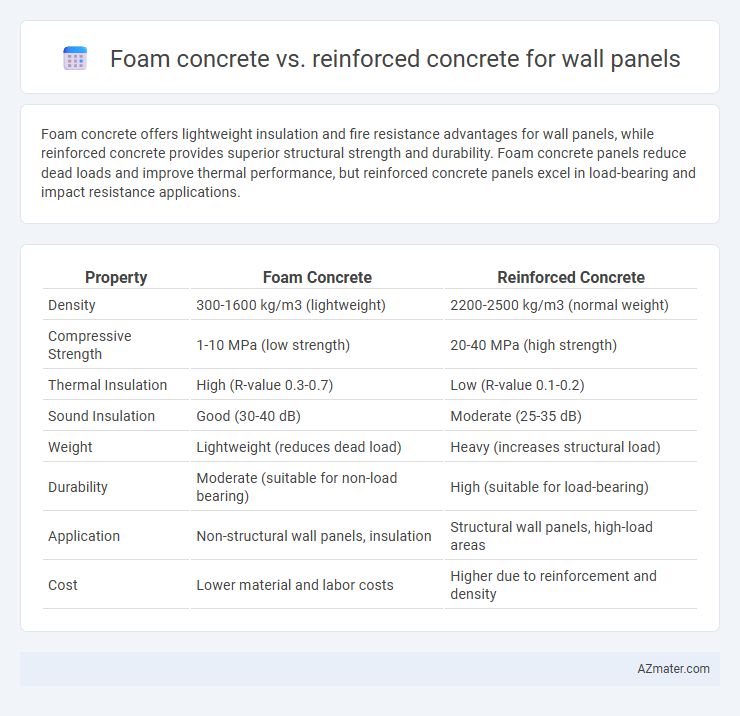Foam concrete offers lightweight insulation and fire resistance advantages for wall panels, while reinforced concrete provides superior structural strength and durability. Foam concrete panels reduce dead loads and improve thermal performance, but reinforced concrete panels excel in load-bearing and impact resistance applications.
Table of Comparison
| Property | Foam Concrete | Reinforced Concrete |
|---|---|---|
| Density | 300-1600 kg/m3 (lightweight) | 2200-2500 kg/m3 (normal weight) |
| Compressive Strength | 1-10 MPa (low strength) | 20-40 MPa (high strength) |
| Thermal Insulation | High (R-value 0.3-0.7) | Low (R-value 0.1-0.2) |
| Sound Insulation | Good (30-40 dB) | Moderate (25-35 dB) |
| Weight | Lightweight (reduces dead load) | Heavy (increases structural load) |
| Durability | Moderate (suitable for non-load bearing) | High (suitable for load-bearing) |
| Application | Non-structural wall panels, insulation | Structural wall panels, high-load areas |
| Cost | Lower material and labor costs | Higher due to reinforcement and density |
Introduction to Foam Concrete and Reinforced Concrete
Foam concrete is a lightweight, cellular material made by mixing cement, water, and foam, offering high thermal insulation and reduced structural load for wall panels. Reinforced concrete consists of cement, aggregates, water, and embedded steel reinforcement bars, providing superior strength and durability for load-bearing applications. Wall panels made from foam concrete emphasize energy efficiency and ease of installation, while reinforced concrete panels deliver enhanced structural integrity and resistance to bending and shear forces.
Composition and Material Properties
Foam concrete consists of cement, water, and foam, resulting in a lightweight, porous material with excellent thermal insulation and low density, while reinforced concrete incorporates steel rebars within a dense cement and aggregate matrix, offering superior tensile strength and load-bearing capacity. The air voids in foam concrete reduce weight and thermal conductivity but limit structural strength, making it ideal for non-load-bearing wall panels, whereas reinforced concrete provides durability and resistance to compressive and tensile forces, suitable for structural wall panels. Material density of foam concrete typically ranges from 400 to 1,600 kg/m3, compared to 2,400 kg/m3 for reinforced concrete, underscoring significant differences in strength and insulation properties.
Structural Strength and Load-Bearing Capacity
Foam concrete has a lower structural strength and load-bearing capacity compared to reinforced concrete, making it more suitable for non-load-bearing wall panels. Reinforced concrete incorporates steel reinforcement bars that significantly enhance its tensile strength and ability to withstand heavy loads and structural stresses. For wall panels requiring high durability and load-bearing capability, reinforced concrete remains the superior choice.
Insulation and Thermal Performance
Foam concrete offers superior insulation and thermal performance for wall panels due to its low density and high air content, which significantly reduce heat transfer compared to reinforced concrete. Reinforced concrete, while strong and durable, has higher thermal conductivity, leading to increased heat loss and requiring additional insulation materials to achieve energy efficiency. The inherent thermal resistance of foam concrete makes it an ideal choice for energy-efficient building envelopes, enhancing indoor comfort and reducing heating and cooling costs.
Durability and Lifespan
Foam concrete wall panels offer excellent durability due to their lightweight structure and resistance to thermal cracking, but reinforced concrete panels provide superior strength and longevity, often exceeding 50 years in lifespan under proper maintenance. Reinforced concrete's high compressive and tensile strength ensures better performance against environmental stresses, making it more suitable for load-bearing applications. Foam concrete, while providing good insulation and fire resistance, typically has a shorter lifespan and may require more frequent repairs compared to reinforced concrete panels.
Construction Speed and Workability
Foam concrete offers faster construction speed for wall panels due to its lightweight nature and ease of handling, allowing quick on-site pouring and shaping without heavy machinery. Reinforced concrete requires longer curing times and more labor-intensive processes involving steel reinforcement placement and formwork, which slows down overall workflow. Workability of foam concrete is enhanced by its flowability and self-leveling properties, whereas reinforced concrete demands skilled labor for proper reinforcement alignment and vibration to prevent voids.
Cost Comparison and Economic Considerations
Foam concrete wall panels typically offer lower material and transportation costs due to their lightweight nature, reducing foundation expenses and labor requirements compared to reinforced concrete panels. Reinforced concrete, while more expensive upfront because of steel reinforcements and higher density, provides superior structural strength and durability that may lower maintenance and replacement costs over time. Economic considerations favor foam concrete for budget-sensitive projects emphasizing insulation and quick installation, whereas reinforced concrete suits applications demanding long-term robustness and load-bearing capacity.
Environmental Impact and Sustainability
Foam concrete offers significant environmental benefits over reinforced concrete by utilizing lightweight materials and reducing cement content, which lowers CO2 emissions during production. Its enhanced thermal insulation properties contribute to energy savings in buildings, promoting sustainability through decreased heating and cooling demands. In contrast, reinforced concrete relies heavily on cement and steel reinforcement, both energy-intensive to produce, resulting in a higher carbon footprint and less eco-friendly lifecycle.
Typical Applications in Wall Panel Construction
Foam concrete is frequently used in wall panel construction for thermal insulation and lightweight partition walls, especially in residential buildings and interior applications due to its excellent fire resistance and soundproofing properties. Reinforced concrete wall panels are preferred in structural and load-bearing applications such as commercial buildings, industrial facilities, and high-rise constructions, offering superior strength and durability. Typical applications highlight foam concrete for energy-efficient, non-structural panels, while reinforced concrete serves as the primary material for load-resisting exterior and shear walls.
Choosing the Right Material for Your Project
Foam concrete offers lightweight insulation and excellent thermal properties, making it ideal for non-load-bearing wall panels where energy efficiency is a priority. Reinforced concrete provides superior structural strength and durability, suited for load-bearing panels requiring high resistance to stress and environmental factors. Choosing between foam and reinforced concrete depends on project requirements such as load capacity, insulation needs, and cost considerations.

Infographic: Foam concrete vs Reinforced concrete for Wall panel
 azmater.com
azmater.com